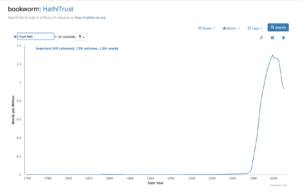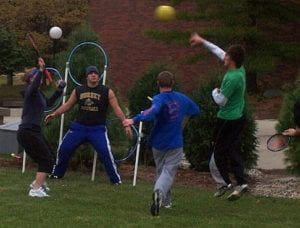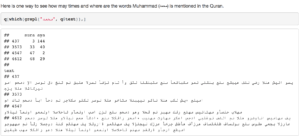Week 1 Introduction
A (28 Jan) Introduction to the Course
Computers and Reading: past and future
Syllabus & Requirements
Former semesters’ work

B (30 Jan) Speed Reading: Fantasy? Fiction?
Read: Speed Reading ; “How Many Books Will You Read Before You Die?”; “The Beginning of Silent Reading”
Watch: Speed Reading Demonstration (Johnny Carson Show); “How to Speed Read”
Discussion: What is reading? Why do we want to read more? not want to read more? Why is speed important to some? How do people manage to speed read? How might we say that computer speed up our reading? What is the meaning of the expression “so many books, so little time”?
NB: These questions are for guiding our discussion only. They are not anything you have to prepare in writing. Taking notes is a good way of remembering what topics you would like to bring up in discussion though.
Week 2
A (4 Feb) An Introduction to Zotero (Justin Parrott)
You will be curating am open Zotero group library on a topic of your choice. You should have about 25-35 articles by the due date. More information about the specific form of this web-based “annotated bibliography” is forthcoming.
Read: “Student Zotero DH S19”; Quick Start Guide
Possible topics: Artificial Intelligence and Education, Punch cards, Early Computers, Speech to Text technologies, OCR, NLP for [language of your choice]; Distant vs Close Reading; Gender and Style … What others can you think of?
B (6 Feb) No Class (to be made up-instructor traveling)
Blog 0: What is a topic related to computers and reading that you would like to investigate in your Zotero bibliography? At the end of the semester you will briefly summarize the big themes of the topic. Investigate a topic and write about 200 words about it using Word or docs for now. What are some keywords? This blog will not be graded, but you will transfer it to your web hosting later. (for use in class on 5 March)

Week 3
A (11 Feb) “Reading” Lots of Books with a Computer
Read: The Mechanic Muse: What is Distant Reading?
Explore: Google n-gram vs. BookWorm
Watch: “What We Learned from 5 Million Books”
Download: Laurence Anthony’s AntConc
Skim: “Corpus Analysis with Antconc.” (Froelich) (also available in Spanish and French)
Short introduction to the Writing Center (Samia)

Muggle Quidditch
B (13 Feb) An Introduction to Web Hosting
(CLASS MEETS FROM TODAY ON IN C2 339 – the conference room for the Center of Digital Scholarship)
Read: What is Fan Fiction? (Wikipedia) ; Harry Potter fandom (Wikipedia)
Exercise with Harry Potter fan fiction texts (in drive) – check out a long list of 300 some examples. Instructor Demo with AntConc and HP fan fiction
Blog 1: Using AntConc, what were you able to conclude about the Harry Potter fan fiction texts we worked with? How are they different? How can you use the concordancing function, as well as the clusters / n-grams and collocation to gain insight into the different texts? Be sure to discuss the parameters you used and how they might impact your analysis. This posting should be put into your WP installation as a post. Posts can be maximum 500 words and should include visual and use the affordances of the WP platform. (DUE: 19 Feb 21 Feb)
Week 4
A (18 Feb) Concordances of the Past
Introduction, The Priest and the Punch Cards (Jones) – instructor will present this in class
The book’s companion tumblr
Share: Discuss the experience of punch-card chatting with your partner.
Read: On the punched card era
Thinking-Through the History of Text Analysis – in Drive
Hands on in class: Setting up a WordPress instance in web hosting.
Trying the Punch Card Emulator or the Virtual Keypunch (download and email your punchcard to a classmate for a “chat” from the past); then go watch a restored 1964 IBM 029 (one of the formats available in the Punch Card Emulator) in action.
Discussion: Imagine writing your code on a punchcard machine. Imagine working without a screen. What do you notice about the machines? their sounds? the keyboards?
Use one of your favorite punchcards as an image on your WP. Prepare this for 20 Feb.

B (20 Feb) Reading all of Anything
Read: Who was Jane Austen? Skim here and here.
Exploratory Data Analysis (EDA)
Install: R & RStudio
Hands on in class: Reading all of Jane Austen in a Few Seconds with the online version of Voyant Tools.
Hands on in class: Learning some R for text analysis; “Tidy Austen”
Advanced: (Try to) Download: Voyant Tools, server version–so you can run it on your own system. Instructions here. OR try Text Mining the Qur’an with R
Discussion: How would you characterize this way of reading? Does this put you out of your comfort zone? What was lost in this reading?
Blog 2: Discuss some of your findings about the works of Jane Austen. How were the works different? Is there progression over time? Be sure to use visuals embedded in your writing. You can even try to embed a live visualization if it comes from Voyant. (due 28 Feb 14 March).
Week 5
A (25 Feb) The List of Instructions
Discussion of your Zotero library ideas (due 7 April).
Recap of RStudio with Tidy Austen
Read: Can Computers Read (Literature)? (Kestemont / Herman)
Watch: The short film entitled An Introduction to Digital Computers (1969). What distinctions does it make between analog and digital computers?
Notice some of the claims of the film:
The notion that an electronic digital computer is a brain is a common misconception. Largely due to a lack of knowledge about the functions and abilities of a computer (1:35).
A digital computer is not a brain, although the nature of its functions parallel those performed by a human being (8:20).
How does a computer know what to do and when to do it? With man, the execution of a particular problem is comparatively easy, since conditioning, education and intelligence make it almost an automatic process. However, the computer doesn’t possess any of these attributes (14:10).
We have seen how a computer performs essentially the same functions as man, the main difference lies in the computer’s greater speed, and its capacity for a huge amount of data. We have caught a glimpse of its so-called intelligence (16:25).
The comparison between computer and man becomes almost unbelievable… (20:35)
Computers are providing man with more time for creativity. They are greatly aiding the generation of today in ways undreamed of a few short years ago, as they shall aid the judgment and intelligence of those yet to be heard from (21:30).
What is the actor doing at 14:49 with the stencil? What is a flow chart? (15:10).
Notice also all the other metaphors used in the short film: memory, clock, control, logic blocks, knowledge, calculating one’s taxes, intelligence. How does the short film handle the issue of man being replaced by a computer?
Blog 3: What are your reactions to this short film? Can you bring it into dialogue with the article by Kestemont/Herman? What were early visions of the computer? What did people hope it could do? What were its limitations then? How do these compare with a perspective from 2019? Can you compare the kinds of reading in the article with intelligence as it is portrayed in the film? (due 2 March 30 March)
B (27 Feb) Putting Together a Corpus from Project Gutenberg (1)
Read: History and Philosophy of Project Gutenberg | Project Gutenberg
On the Difference between AI and AGI
Who was Mary Hazel Blanchard Wade? What was manifest destiny?
Review: Can Computers Read (Literature)? (Kestemont / Herman)
Explore: Read about Open Culture.
Hands on in class: Trying out the gutenbergr package (The Notebook is in Drive)
Who put together Project Gutenberg? Why did they do it? What is the importance of free culture? What sets of texts do you want to read together with a computer? What possibilities does such sped-up reading provide for comparative, exploratory analysis? What other texts that interest you that may not have been gathered together? Can you use materials from openculture.com to build a corpus?
Why do you think that Mary Hazel Blanchard Wade was called “Manifest Destiny’s Child” by a critic? She had a lot of partners that can be found here. What can you discover about them: Mary F. Nixon-Roulet, Blanche McManus, Elizabeth R. MacDonald, Isaac Taylor Headland, H. Lee M. Pike, E. C. Shedd, Edward C. Butler, Claire Martha Coburn, Clara V. Winlow, Luna May Ellis, Fedor Alexis Postnikov, Florence Emma Voigt Mendel?

Week 6
A (3 Mar) Repeating last week’s exercise with the GutenbergR project with 3 texts of interest
B (5 Mar) Analyzing All the State of the Union Addresses from 1790-2016
Hands on: Programming Historian: Basic Text Processing in R
Discussion: What do the metrics that we worked on with the SOTU speeches tell us over time? How can we begin to interpret such numbers?
Week 7
A (10 Mar) Classes suspended by ministerial decree
B (12 Mar) Classes suspended by ministerial decree
****** WE SUSPENDED INSTRUCTION HERE. PLEASE REFER TO THE REMOTE TABS FOR THE REVISED SCHEDULE WHILE WE ARE OUT OF THE CLASSROOM ******
Week 8 Computers reading aloud
A (17 Mar) Accessibility and screen readers
So that we can have a conversation about accessibility and screen text, we will be experimenting with ways that computers read aloud.
Download: In preparation for class, please download one of these screen readers and try to make it work with a web page or document. We will also use the reading function in Adobe Acrobat. (Write some notes so that you can share your experience.
Watch: NYU Digital Accessibility | Accessible Web Design
Explore: Accessible Color Generator
Read: NYU Digital Accessibility Checklist | Policy
Discussion: What does accessibility have to do with searchable text? Is accessibility for the screen only for the visually impaired? What are important points of accessibility ? What kinds of screen readers exist? How much do they cost? How do they work? What is the difference between English and non-English content for screen readers? What are the parts of a WP post that we ignore usually that make a difference for screen readers?
In-class exercise: We will go back to blog 0 and post it while thinking about accessibility issues.
B (19 Mar) Computers Reading Handwriting (2)
Read: Take a look at these LOC crowdsourcing projects : Disabled, but Not Disheartened | The Rosa Parks Papers | Letters to Lincoln
“Transkribus Makes a Breakthrough in Understanding Ancient Texts“
“Transcribing Foucault’s Handwriting with Transkribus”
In class: Let’s transcribe this text from the Bushire Residency Papers part of the OpenGulf project. Let’s Take a look at the Transkribus interface.
What is crowdsourcing? What is HTR? What is the difference between the two? On what kinds of materials would you use one or the other?
20-28 Mar Spring Break!
INDIVIDUAL MIDTERM PROJECT: You will design a corpus of materials from Project Gutenberg, justifying why those materials fit together in a way that helps you explore a research question. You will try out the gutenbergr package, run some analysis and discuss the results. Please make sure that you related you project in relation to the readings thus far. Please combine the “surface or distant” analysis with some close up analysis. Be sure to include visuals. 750 words + visuals (DUE: 5 April)
Week 9
Final individual project ideation (in class and via Zoom)
A (31 Mar) From Voice to Corpus (3): NYU Stream | From Epub to corpus (4): Calibre
What other kinds of voices and texts can we read with a computer? Take a look Open Subtitles for subtitles of movies and series.
Read: “Distant Reading After Moretti” (Klein)
“On the Way to Computational Thinking” (Berry/Fagerjord) – in drive
What is NYU Stream?
Instructor demo: Calibre and epubs
Let’s brainstorm for a corpus to create with Stream : YouTube videos, podcasts
Blog 4: What would be your ideal corpus to put together if you had a lot of time and money? What kinds of methods would you use to do that? OCR? HTR? Speech-to-text technologies? What realistic corpus will you put together for your final project? (Due: 10 Apr)
B (2 Apr) Is Style Computable?
Reading: “Revisiting Style: A Key Concept in Literary Studies” (excerpt Herrmann et al Style JLT).
The stylo package for R for “countable features”
Prepare: Place 5 texts of your favorite author (could be yourself or your friend) into drive
Week 10
A (7 Apr) Detecting Authorship
The Little Cousin series | Political speeches
B (9 Apr) Topic Modeling
“Topic Modeling Martha Balard’s Diary” (Blevins)
“Topic Modeling and Digital Humanities” (Blei)
https://github.com/senderle/topic-modeling-tool
Blog 5: Discuss either your experiment in computational stylistics or topic modeling. What set of materials did you use? What did the results suggest to you? (Due: 15 Apr)
Week 11
A (14 Apr) Topic Modeling and the Archive
Topic Modeling Little Cousin / Topic Modeling Gulf History / Topic Modeling 1001 Nights
Discussion: In what kinds of scenarios do you think topic would be an interesting way of reading? what can it tell us? what can it not tell us?
B (16 Apr) Sentiment and your corpus
https://www.kaggle.com/rtatman/tutorial-sentiment-analysis-in-r
Blog 6: What do you think about the idea of sentiment analysis? Can it be useful despite what Dobson calls “a deeply ahistorical understanding of sentiment and sentimentality” (86)? What for?
Week 12
A (21 Apr) Sentiment and Twitter
https://towardsdatascience.com/twitter-sentiment-analysis-and-visualization-using-r-22e1f70f6967
B (23 Apr) Imagining a Computer-Assisted reading project – planning session
Week 13
A (28 Apr) Futures of Reading
“How Amazon Tracked my Last Two Years of Reading“
Hayles, “How We Read” in Drive
B (30 Apr) Futures of Reading
“The Machines Are Learning, So Are the Students”
“Why We Don’t Read – Revisited”
Blog 7: Write a note to a family member in non-technical language about what you learned in this course. Why was it useful? Why was it difficult? Describe how you think people will read in the future. Feel free to include visuals, even a scanned or photographed hand-drawn image (due: 9 May)
Week 14
A (5 May) Presentations of works in progress (sign up)
B (7 May) Presentations of works in progress (sign up)
Week 15
10 May Makeup session Final Lab 1
A (12 May) Final Lab 2
B (14 May) Final Lab 3
All final work due 15 May, 11:59pm.
